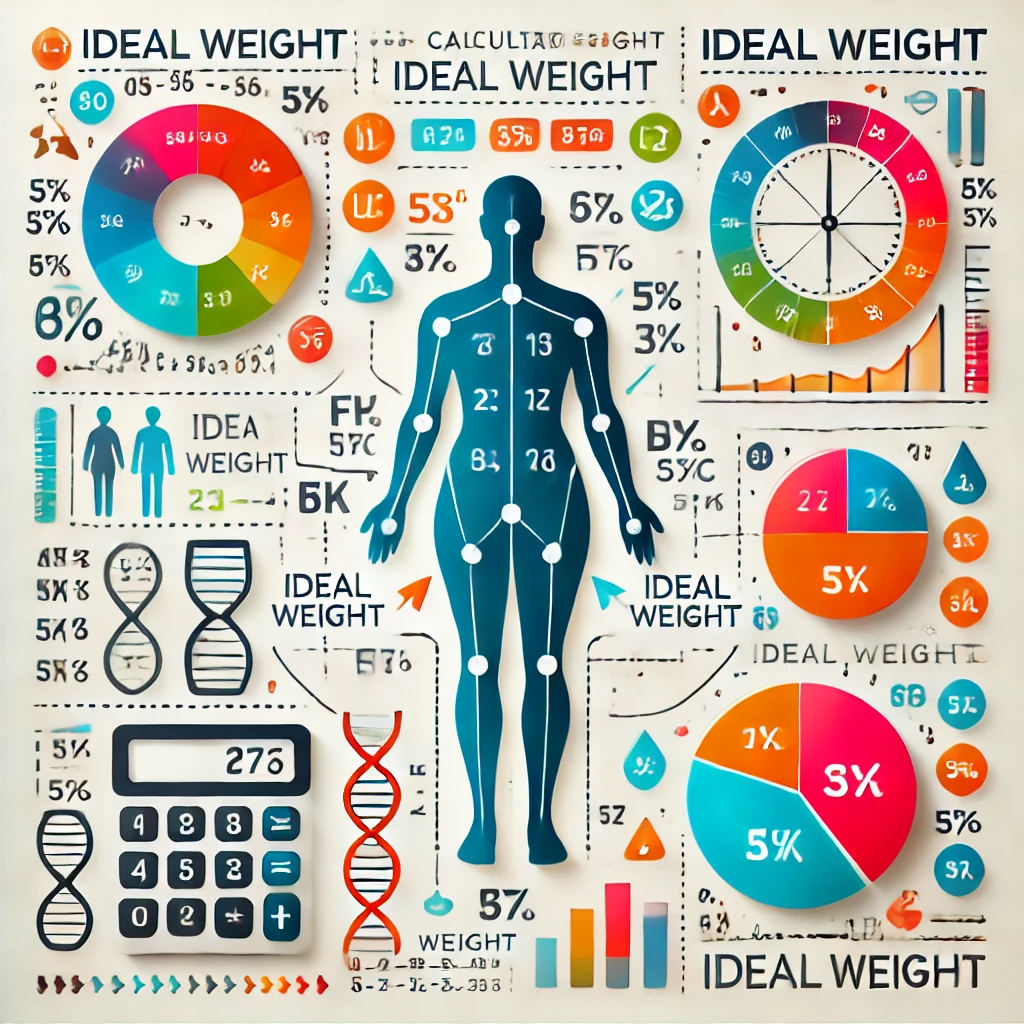Ideal Weight Calculator
Pelank Life ©
The Ideal Weight Calculator estimates the ideal body weight (IBW) range based on height and gender. The concept of finding IBW using a formula has long attracted the attention of many experts. Currently, several popular formulas exist, and our Ideal Weight Calculator provides their results for side-by-side comparison.
Pelank © Beta Version of the Ideal Weight Calculator
محاسبهگر وزن ایدهآل
نتیجه وزن ایدهآل شما
| فرمول | وزن ایدهآل (کیلوگرم) | توضیحات علمی |
|---|---|---|
| Devine | دیواین | پرکاربرد در پزشکی بالینی و داروشناسی | |
| Miller | میلر | مبنای طب نوین و مطالعات دهه ۸۰ میلادی | |
| Robinson | رابینسون | اصلاحشده برای قد کوتاهتر | |
| Hamwi | هموی | سادهترین الگوریتم وزنی کلاسیک | |
| محدوده وزن سالم (BMI) | بر اساس شاخص توده بدنی ۱۸.۵ تا ۲۴.۹ |
اگر بدن شما عضلانی و کمچربی است (مانند ورزشکاران یا بدنسازان)، این فرمولها لزوماً نمایانگر وزن سالم شما نیستند و ممکن است وزن ایدهآل نمایش دادهشده کمتر از واقعیت باشد.
برای تحلیل دقیقتر: باید درصد چربی بدن یا ترکیب بدن (آنالیز InBody یا DEXA) را اندازهگیری کرده و با مشاور حرفهای مشورت نمایید.
Pelank Life | Body Health Assessment
The Best Body Health Calculators Using Scientific Methods
Developed by Pelank Life ©
What Should Our Weight Be?
Understanding Ideal Weight
Most people have tried to lose weight at some point in their lives, or at least know someone who has.
This is mainly due to the perception of an “ideal” body weight, which is often shaped by what is promoted in various media such as social networks, television, movies, magazines, and so on.
Estimating IBW
Although ideal body weight (IBW) is sometimes estimated today based on visual appeal, IBW was originally introduced to estimate medical drug dosages, and the formulas calculating it have no relation to how a person appears at a certain weight. Since then, it has been established that the metabolism of some drugs depends more on IBW than on total body weight.
Today, IBW is also widely used in sports, as many sports classify individuals based on their body weight.

Reviewing the IBW Criterion
Note that IBW is not a perfect or precise measurement. It does not take into account an individual’s body fat percentage or muscle mass. This means that healthy, fit athletes with a high IBW might appear overweight. Therefore, IBW should be viewed as an incomplete measurement and does not necessarily indicate a person’s health or the weight they should achieve. A person may be above or below their “IBW” and still be completely healthy.
Is IBW an Exact Science?
Determining the exact weight a person should have is not an exact science. It depends heavily on the individual. To date, no standard—whether IBW, Body Mass Index (BMI), or any other measure—can definitively state what weight a person must have to be healthy. These are merely references. More important than following a specific weight based on a general formula is adopting healthy lifestyle choices such as regular exercise, eating a variety of unprocessed foods, getting enough sleep, and so on.
However, many factors can influence ideal weight; the most important of these are listed below. Other factors include health conditions, fat distribution, genetics, and more.
Age
Theoretically, age should not be a significant factor in determining IBW after ages 14-15 for girls and 16-17 for boys, as most individuals stop growing after these ages. In fact, it is expected that men and women lose approximately 1.5 and 2 inches in height, respectively, by the age of 70. It is important to remember that with aging, muscle mass decreases and accumulating excess fat becomes easier. This is a natural process, although its effects can be mitigated by adopting different habits such as monitoring diet, exercising, managing stress, and ensuring adequate sleep.
Gender
In general, women weigh less than men, even though they naturally have a higher body fat percentage. This is because men typically have more muscle mass, and muscle is denser and heavier than fat. Additionally, women usually have lower bone density. Finally, men are generally taller than women.
Height
The taller a person is, the more muscle and fat mass they tend to have, resulting in a higher weight. A man of similar height to a woman is generally expected to weigh about 10-20% more.
Frame Size
Frame size is another factor that can significantly affect the measurement of ideal weight. Frame size is typically classified as small, medium, or large, based on the ratio of a person’s wrist circumference to their height.
For Women:
- Height under 5’2″:
- Small Frame = Wrist circumference less than 5.5 inches
- Medium Frame = Wrist circumference between 5.5 and 5.75 inches
- Large Frame = Wrist circumference greater than 5.75 inches
- Height between 5’2″ and 5’5″:
- Small Frame = Wrist circumference less than 6 inches
- Medium Frame = Wrist circumference between 6 and 6.25 inches
- Large Frame = Wrist circumference greater than 6.25 inches
- Height over 5’5″:
- Small Frame = Wrist circumference less than 6.25 inches
- Medium Frame = Wrist circumference between 6.25 and 6.5 inches
- Large Frame = Wrist circumference greater than 6.5 inches
For Men:
- Height over 5’5″:
- Small Frame = Wrist circumference between 5.5 and 6.5 inches
- Medium Frame = Wrist circumference between 6.5 and 7.5 inches
- Large Frame = Wrist circumference greater than 7.5 inches
A person with a large frame naturally weighs more than someone with a small frame, even if they are the same height. Therefore, frame size is an important factor in measurements like IBW and BMI.

Formulas for Calculating Ideal Weight
IBW formulas were primarily developed to simplify drug dosage calculations. All these formulas follow a similar pattern where a base weight is set for a height of 5 feet, and a specific amount is added for each inch above 5 feet. For example, if you are a man who is 5’10” tall and want to calculate your ideal weight using the Devine formula, you would add (2.3 × 10) kilograms to 50 kilograms, resulting in 73 kilograms.
The formulas differ in the values they use based on research conducted by respective scientists, resulting in varying outcomes. The Devine formula is the most commonly used method for measuring IBW.

G. J. Hamwi Formula (1964)
Men: 48.0 kilograms + 2.7 kilograms for each inch over 5 feet
Women: 45.5 kilograms + 2.2 kilograms for each inch over 5 feet
B. J. Devine Formula (1974)
Men: 50.0 kg plus 2.3 kg for every inch over 5 feet.
Women: 45.5 kg plus 2.3 kg for every inch over 5 feet.
J. D. Robinson’s formula (1983)
Men: 52 kg plus 1.9 kg for every inch over 5 feet.
Women: 49 kg plus 1.7 kg for every inch over 5 feet.
D. R. Miller’s formula (1983)
Men: 56.2 kg plus 1.41 kg for every inch over 5 feet.
Women: 53.1 kg plus 1.36 kg for every inch over 5 feet.
Healthy BMI range
The healthy BMI range according to the World Health Organization (WHO) for both genders is between 18.5 and 25. Based on this range, a healthy weight can be determined for any given height.
BMI is a common measure used to determine Ideal Body Weight (IBW) and serves as a quick indicator in medical settings for the risk of health problems. Generally, the higher the BMI, the greater the likelihood of developing health issues such as obesity, diabetes, heart disease, and others.

Healthy BMI range for children
All the formulas above apply to adults aged 18 and older. For children and adolescents, refer to the BMI charts published by the Centers for Disease Control and Prevention (CDC).
Limitations of the IBW calculator
All formulas and methods have limitations. Since these formulas are designed to be applicable to a wide range of individuals, they cannot be accurate for every person. They only consider height and gender and do not take into account physical disabilities, activity levels, or the ratio of muscle mass to body fat (known as body composition).
Conclusion
Ideal Body Weight (IBW) is a measure that can help estimate a healthy weight based on your height and gender, but it should not be the sole criterion for assessing an individual’s health. Other factors such as body composition, activity level, and overall health status are also important.